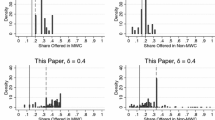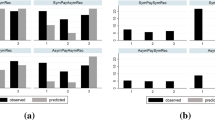Abstract
We analyze the data sets of all majoritarian Baron and Ferejohn (Am Political Sci Rev 83(4):1181–1206, 1989) experiments through 2018. By exploiting the variation of the experimental parameters, we are able to identify how group size, discount factor (cost of agreement delay), voting weights, and communication affect bargaining outcomes and dynamics. The outcomes are qualitatively in line with the stationary subgame perfect equilibrium, i.e., minimum winning coalitions are modal; proposers demand larger shares than non-proposers; and most agreements are reached without delay. Experience and communication between players move outcomes closer to the equilibrium. However, bargaining dynamics are not stationary. Behavior following a disagreement is history-dependent in the form of retaliation towards failed proposers and their supporters, which, if rationally expected, may deter proposers from demanding high shares.





Similar content being viewed by others
Notes
In this article, we focus on the closed amendment rule that has received wide attention. A version of the model where another player must agree to move a proposal for a vote is not discussed here.
We include treatments that yield symmetric predictions and in which the funds to be distributed are exogenous in our analysis. We also incorporate treatments that allow for costless communication.
We have three group sizes, communication treatments, and six discount factors from 0.5 to 1, for a total of 10 treatments. Not all combinations of discounting, group sizes, and communication have been investigated. We explain our sample and selection criteria in Sect. 3.
See Section 3.1 in Norman (2002).
See Section 3 in the Online Appendix for a study-by-study explanation of which treatments were included.
In the body of the paper we focus on multilevel random effects models. Our results are robust to clustering at the study level and having only subject random effects.
This only holds for \(\delta \in (0,1]\), not for \(\delta =0\).
We are especially grateful to the anonymous referees who offered valuable insights regarding the sample selection for regression analysis.
In Table 1 of the Online Appendix we conduct the same regressions focusing only on treatments without communication and the results remain.
In further regression analysis that we conduct below, we find that discounting starts to have the equilibrium predicted effect on behavior as subjects gain experience.
Recall that, in our sample of analysis, some experiments have asymmetric weights yet all predict symmetric expected values, thus the proposer’s share should be independent of them according to the SSPE.
The net effect of \(\delta\) on the proposer’s share becomes significantly negative after period 13 in groups of 3 and period 11 in groups of 5 (Wald tests yield p=0.083 and p=0.078, respectively).
It is 60.1 percent of all round 1 proposals, 60.2 of accepted proposals.
An equal split is defined as a division of the pie in which each member’s share is within 5 percentage points of \(\frac{1}{\text {Group Size}}\).
For consistency with our previous estimations, we initially conducted a mixed effects probit regression with study, but we reject this specification in favor of the OLS model (L.R. test, p-value>0.1). The variance estimates were not significant at conventional levels and the intra-class correlation coefficients were below 5 percent in each cluster level.
The reason we estimate OLS regressions is because we were unable to estimate probit regression models for groups of 5 due to lack of convergence in the maximization of the likelihood function. We attempted several integration methods and parameters, but could not obtain convergence. Probit model estimations for all other cases lead to similar conclusions to those obtained from the linear probability models shown here.
In treatments with communication, there are only 6 observations in groups of 3 and 9 observations in groups of 5 thus we cannot conduct a separate analysis.
The p-values are obtained from linear regressions clustering at the study level controlling for experience.
A similar result holds when focusing on whether a member is included or excluded from the coalition. See Figure 1 in the Online Appendix.
References
Adams, J. S. (1965). Inequity in social exchange. In Advances in experimental social psychology (Vol. 2, pp. 267–299). Elsevier.
Agranov, M. (2020). Legislative bargaining experiments. Private communication with the author. To appear in “Bargaining: Current Research and Future Directions” edited by Emin Karagozoglu and Kyle Hyndman
Agranov, M., & Tergiman, C. (2014). Communication in multilateral bargaining. Journal of Public Economics, 118, 75–85.
Baranski, A. (2016). Voluntary contributions and collective redistribution. American Economic Journal: Microeconomics, 8(4), 149–73.
Baranski, A., & Kagel, J. H. (2015). Communication in legislative bargaining. Journal of the Economic science Association, 1(1), 59–71.
Baron, D. P., & Ferejohn, J. A. (1989). Bargaining in legislatures. American political science review, 83(4), 1181–1206.
Bolton, G. E., & Ockenfels, A. (2000). Erc: A theory of equity, reciprocity, and competition. American Economic Review, 90(1), 166–193.
Bradfield, A. J., & Kagel, J. H. (2015). Legislative bargaining with teams. Games and Economic Behavior, 93, 117–127.
Diermeier, D., & Gailmard, S. (2006). Self-interest, inequality, and entitlement in majoritarian decision-making. Quarterly Journal of Political Science, 1(4), 327–350.
Diermeier, D., & Morton, R. (2005). Experiments in majoritarian bargaining. Social choice and strategic decisions (pp. 201–226). Springer.
Drouvelis, M., Montero, M., & Sefton, M. (2010). Gaining power through enlargement: Strategic foundations and experimental evidence. Games and Economic Behavior, 69(2), 274–292.
Eraslan, H., & Evdokimov, K. S. (2019). Legislative and multilateral bargaining. Annual Review of Economics, 11(1), 443–472.
Fehr, E., & Schmidt, K. M. (1999). A theory of fairness, competition, and cooperation. The Quarterly Journal of Economics, 114(3), 817–868.
Fréchette, G., Kagel, J. H., & Morelli, M. (2005a). Behavioral identification in coalitional bargaining: An experimental analysis of demand bargaining and alternating offers. Econometrica, 73(6), 1893–1937.
Fréchette, G., Kagel, J. H., & Morelli, M. (2005b). Nominal bargaining power, selection protocol, and discounting in legislative bargaining. Journal of Public Economics, 89(8), 1497–1517.
Fréchette, G. R., Kagel, J. H., & Lehrer, S. F. (2003). Bargaining in legislatures: An experimental investigation of open versus closed amendment rules. American Political Science Review, 97(2), 221–232.
Fréchette, G. R., & Vespa, E. (2017). The determinants of voting in multilateral bargaining games. Journal of the Economic Science Association, 3(1), 26–43.
Harrington, J. E. (1990). The role of risk preferences in bargaining when acceptance of a proposal requires less than unanimous approval. Journal of Risk and Uncertainty, 3(2), 135–154.
Kagel, J. H., Sung, H., & Winter, E. (2010). Veto power in committees: an experimental study. Experimental Economics, 13(2), 167–188.
Maaser, N., Paetzel, F., & Traub, S. (2019). Power illusion in coalitional bargaining: An experimental analysis. Games and Economic Behavior, 117, 433–450.
McKelvey, R. D. (1991). An experimental test of a stochastic game model of committee bargaining. In T. R. Palfrey (Ed.), Contemporary Laboratory Research in Political Economy. Ann Arbor: University of Michigan Press.
Miller, L., Montero, M., & Vanberg, C. (2018). Legislative bargaining with heterogeneous disagreement values: Theory and experiments. Games and Economic Behavior, 107, 60–92.
Miller, L., & Vanberg, C. (2013). Decision costs in legislative bargaining: An experimental analysis. Public Choice, 155(3–4), 373–394.
Miller, L., & Vanberg, C. (2015). Group size and decision rules in legislative bargaining. European Journal of Political Economy, 37, 288–302.
Montero, M. (2007). Inequity aversion may increase inequity. The Economic Journal, 117(519), C192–C204.
Morelli, M. (1999). Demand competition and policy compromise in legislative bargaining. American Political Science Review, 93(4), 809–820.
Norman, P. (2002). Legislative bargaining and coalition formation. Journal of Economic Theory, 102(2), 322–353.
Nunnari, S., & Zapal, J. (2016). Gambler’s fallacy and imperfect best response in legislative bargaining. Games and Economic Behavior, 99, 275–294.
Palfrey, T. R. (2016). Experiments in political economy. In J. H. Kagel & A. E. Roth (Eds.), The Handbook of Experimental Economics (Vol. 2, pp. 347–434). Princeton University Press, Princeton.
Tversky, A., & Kahneman, D. (1974). Judgment under uncertainty: Heuristics and biases. Science, 185(4157), 1124–1131.
Acknowledgement
We would like to thank Marina Agranov, Anthony Bradfield, Daniel Diermeier, Guillaume Frechette, Sean Gailmard, Tanushree Jhunjhunwala, John H. Kagel, Luis Miller, Maria Montero, Hankyoung Sung, and Chloe Tergiman for kindly sharing their data sets and explaining their structure in detail to us. Without their help, it would been impossible to write this article. Sima Basel and Luis Quesada offered excellent research assistance. We are also grateful for the valuable comments provided by participants at the 4th Bargaining Experiments, Empirics, and Theory (BEET) workshop, Olivier Bochet, Simon Siegenthaler, as well as the generous guidance provided by the Editor, Roberto Weber, and two anonymous referees. Baranski gratefully recognizes financial support by Tamkeen under the NYU Abu Dhabi Research Institute Award CG005. All errors remain our own.
Author information
Authors and Affiliations
Corresponding author
Additional information
Publisher's Note
Springer Nature remains neutral with regard to jurisdictional claims in published maps and institutional affiliations.
Supplementary Information
Below is the link to the electronic supplementary material.
Rights and permissions
About this article
Cite this article
Baranski, A., Morton, R. The determinants of multilateral bargaining: a comprehensive analysis of Baron and Ferejohn majoritarian bargaining experiments. Exp Econ 25, 1079–1108 (2022). https://doi.org/10.1007/s10683-021-09734-7
Received:
Revised:
Accepted:
Published:
Issue Date:
DOI: https://doi.org/10.1007/s10683-021-09734-7




